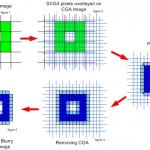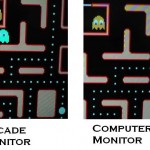CRT vs Flat Panel Monitors
CRT Arcade Monitor
Up until about 2006 (give or take), all authentic arcade games have been designed around CRT arcade monitor technology. Believe it or not, this technology has not kept up to modern TV or computers. In the 80’s to late 90’s, over 98% of arcade games were designed for CGA graphics of approx 320×240. Yes, that’s right! About the same resolution as your old flip cell phone. Some games went on to use EGA and VGA graphics (640×480)… which is the same as a 480i standard resolution TV set. Still, far from even mid 90’s SVGA graphics and today’s high resolution TV and LCD panels.
The question is, why wouldn’t you use a modern display? The answer may be counter intuitive to those not in the video/graphics industry. The short answer is: because it will look horrible.
Why CRT Arcade Monitor Better Than HD?
If you’ve ever seen a regular standard definition (SD) TV show on a modern HDTV set, it looks horrible (and that is standing back at a distance). Imagine what it would be like if you had to get up close to the display like you would with an arcade game. There are a couple factors in why SD transmissions look horrible on HD sets, but one of the contributing factors is the problem of pixel aliasing. While this is not exactly the same issue in arcade games, the results are very similar.
Modern day computer (LCD and CRT) monitors are actually not designed to support lower graphic resolutions and cannot support the slower refresh rates and larger pixel sizes.
Low resolution (CGA) graphics pixel sizes are relatively large and in order to translate these pixels to a higher pitch display, the monitor must be able to upconvert. Additionally, digital monitor pixel sizes are in a fixed size and position on the screen, where as analog pixel sizes (excited phosphor elements) can be adjusted for size and position to match an arcade game’s output 1:1. So unless a modern display is an exact integer ratio of the desired output, it will blur the pixels – and unfortunately, arcade games from the 80’s and 90’s used all sorts of screen resolutions.
These are typical modern monitor (SVGA) resolutions:
- 512 x 448 @ 60Hz
- 512 x 512 @ 60Hz
- 640 x 480 @ 60Hz
- 720 x 480 @ 60Hz
- 800 x 600 @ 50Hz
- 1024 x 768 @ 50Hz
These are typical arcade monitor (CGA) resolutions:
- 240 x 240 @ 60Hz
- 256 x 240 @ 60Hz
- 256 x 256 @ 60Hz
- 256 x 264 @ 60Hz
- 304 x 240 @ 60Hz
- 321 x 240 @ 60Hz
- 321 x 256 @ 60Hz
- 336 x 240 @ 60Hz
- 352 x 256 @ 60Hz
- 352 x 264 @ 60Hz
- 352 x 288 @ 50Hz
- 368 x 240 @ 60Hz
- 384 x 288 @ 50Hz
- 392 x 240 @ 60Hz
- 401 x 256 @ 53Hz
- 448 x 240 @ 60Hz
- 512 x 240 @ 60Hz
- 512 x 288 @ 50Hz
- 632 x 264 @ 56Hz
- 640 x 240 @ 60Hz
- 640 x 288 @ 50Hz
So for example, if you had an arcade game that normally outputs 392 x 240, there is no matching ratio for SVGA.
More Details
One would think that higher resolution digital displays would result in an output that is just as crisp as the original. However, the problem is that the pixels do NOT line up correctly when converting from high to low resolutions… and therefore monitor needs to decide what do to for pixels that essentially hang off the edges.
In our example, for simplicity, we attempt to line up both high and low resolutions using a grid. The grid represents the immovable pixels on a digital monitor.
The following example is a very simple “O” shape, single color graphic. On a CGA (Arcade Monitor), you would see this shape pixel for pixel… and you would expect to see it that way. On a modern monitor, the “O” shape gets rounded off and fuzzy on the inside and outside edges. This is because the GRIDS do not overlay perfectly and the monitor has to decide what to do. For example, if a pixel hangs off 50%, the monitor may reduce the luminance and/or color of that pixel (or possibly just turn it off). Either way, the image becomes distorted and VERY noticeable.
Here are actual close-up photos of MsPacman on a proper arcade monitor VS computer monitor. You can see on the computer monitor the blurry dots, wall edges etc. Now, would you settle for this?
Summary
CRT Arcade monitors are naturally much harder to find in good working order as they are out of production and thus will require technical knowledge to properly rebuild, test and install. Also, we will never take an old tube and “rejuvenate” it (which is a process of inducing high current thru the tube to burn off deposits in order to brighten up the output). This process is only necessary when a CRT is beyond it’s expected life cycle and ends up being a temporary fix. We always use FRESH tubes in all of our monitors
This is why it is important to find experts such as Castle Classic Arcade for a proper and authentic arcade machine for your home.


